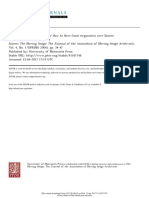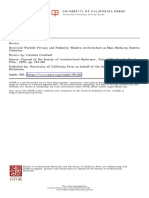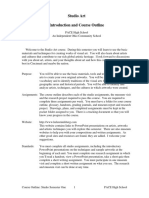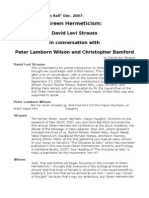Art of Electronics
Art of Electronics
Uploaded by
Iskandar AmirCopyright:
Available Formats
Art of Electronics
Art of Electronics
Uploaded by
Iskandar AmirOriginal Title
Copyright
Available Formats
Share this document
Did you find this document useful?
Is this content inappropriate?
Copyright:
Available Formats
Art of Electronics
Art of Electronics
Uploaded by
Iskandar AmirCopyright:
Available Formats
_NA_ru_~--m_L_
. ~--I~--_~--R_lm------------------CHRISTMASBOOKS--------------------------------~
in a foreword to Fritzsch's book that the
public has paid the bill for this research. Art of electronics does serve a scientific as well as a visual
appetite. Browsing through the 250-odd
So what goes wrong? You need an highly coloured reproductions gives a clear
irreducible minimum of terminology to W. Graham Richards idea of just what is possible with available
identify the most important particles and technology. Any specialist is likely to
the cardinal phenomena; every superfluous Computer Images: State of tbe Art. encounter some of the pictures from his
technical word beyond that will cost you a By Joseph Deken. own publicity calendar, but also to have his
hundred readers. It is also a matter of page- Thames & Hudson/Stewart, Tabor; & imagination stimulated with thoughts of
by-page comprehensibility. When Chang, New York: 1983. Pp.200. extra things one could achieve with the
specialists write for the general reader, they Hbk £15, $25; pbk £9.95, $16.95. appropriate facilities.
all too often assume that something The author suggests that the combin-
explained on page 10 can be referred to CLASSICAL painting never recovered from ation of computer and graphics display
freely again on page 110. These books the invention of photography. The fact may enhance our vision of the universe in
require the reader to have almost total that a near perfect reproduction of reality as dramatic a way as the telescope and the
recall of unfamiliar concepts. can be made has had profound influence microscope. Certainly to anyone working
Then the weird processes of the on the artist. Now the development of com- in science at a molecular level this must be
subatomic world have to be explained as puter image processing has expanded our true. At last the sterile language of mole-
limpidly as possible, to make it clear, for vision far beyond the range of human cular formulae on the printed page can be
example, that force-carrying particles are senses and is likely to have an even more translated into something which, even if
matter-antimatter combinations of the drastic impact on artists, photographers not' 'reality", is nonetheless a very accept-
kinds of durable particles on which they and film-makers. able and comprehensible metaphor.
act. Instead of any such illumination, the Images can be created with which the The format of a book can, of course,
reader of the two books under review finds observer may interact directly. Already it is only hint at the extra dimensions available
more than he is ever likely to want to know possible for trainee pilots to "fly" in when the images can be made both
about the decay of orthopositronium or the totally realistic simulated aircraft and for dynamic and interactive. Despite this
hyperfme splitting of quark clusters. video games to permit battles such as those necessary limitation, however, the illus-
Finally, you must jolly the reader along in the Disney movie Tran. The scope seems trations and accompanying text are suf-
- strew his path with flowers, as Faraday endless, and many of the contemporary ficient to stimulate both seasoned scientists
put it. The human adventure of high- results are quite lovely to behold. and graduate students whose careers are
energy physics, with its heroic experiments Deken has given an accurate title to his likely to be deeply influenced by colour
and its races for one Nobel prize after presentation of the state of the art. In no graphics. 0
another, provides a ready source of jolli- way a technical book, rather it is a collec-
fication. Frequent reminders that abstruse- tion of some of the finest current examples W. Graham Richards is a Lecturer in Physical
Chemistry, Oxford University, and a member of
seeming processes tell us why the universe is of computer generated pictures from a the editorial board of the Journal of Molecular
the way it is, and why familiar objects in it wide spectrum of sources and disciplines. It Graphics.
behave as they do, can also help. Close
works harder at trying to meet this
requirement than Fritzsch does.
There ought to be a society for the pre-
vention of mental cruelty to the general
reader. (Weare all general readers, outside
our own areas of expertise.) It took me
years to discover that relativity, for
example, is quite simple, despite the many
"popular" accounts that make it baffling.
Readers are too often left feeling stupid but
they don't complain because they have no
wish to parade what they take to be their
own deficiencies, rather than the authors'
and publishers'. I doubt whether the
publishers of these two books on particle
physics, who proclaim their clarity and
simplicity, could give any satisfactory
explanation of what the books are about. 0
Nigel Calder is a science writer. His most recent
book on fundamental physics was Einstein's
Universe (BBC Publications. 1979).
• We received a third book on elementary
particles for the layman after Nigel Calder's
review (above) was complete: The Quest for
Quarks by Brian McCusker (Cambridge Uni-
versity Press; £7.95, $14.95). Unfortunately,
it would appear to fall into the same errors
Calder criticizes - but it is relieved by the fact
that McCusker (of the University of Sydney)
believes he and others have discovered free
quarks. Most physicists would reject the claim,
but McCusker argues it well in a 32-page "The Second Nuclear Wars To create
chapter. This raises the book above the usual features of the leaders of the five countries possessing nuclear warheads - Reagan, Brezhnev,
run, and would make it worth reading, say, for Mitterand, Thatcher and Xiaoping. The extent to which each face appears is proportional to the
half-an-hour in the library. Robert Walgale number of warheads in that country.
© 1983 Nature Publishing Group
You might also like
- DLL MATATAG - MUSIC & ARTS 4 Q1 W3 Lesson 2Document23 pagesDLL MATATAG - MUSIC & ARTS 4 Q1 W3 Lesson 2Roswel Placigo100% (1)
- Holmes, The Stereoscope and The StereographDocument12 pagesHolmes, The Stereoscope and The StereographPaloma LimaNo ratings yet
- Baudelaire, The Salon of 1859Document4 pagesBaudelaire, The Salon of 1859Paloma Lima100% (1)
- Computers, Pattern, Chaos and BeautyFrom EverandComputers, Pattern, Chaos and BeautyRating: 4 out of 5 stars4/5 (16)
- Teaching Arts in The Elementary Grades: A. Art DefinedDocument7 pagesTeaching Arts in The Elementary Grades: A. Art DefinedMaricel Viloria80% (5)
- Marks Ethical PresenterDocument15 pagesMarks Ethical PresenterBárbara Robles SotoNo ratings yet
- The Light of BeingDocument2 pagesThe Light of BeingSharique KhanNo ratings yet
- What Is Impressionism_Document7 pagesWhat Is Impressionism_zizheng318No ratings yet
- From the Darkness and the Depths (Cryptofiction Classics - Weird Tales of Strange Creatures)From EverandFrom the Darkness and the Depths (Cryptofiction Classics - Weird Tales of Strange Creatures)No ratings yet
- 5 Electromagnetic Levitation: Per SeDocument2 pages5 Electromagnetic Levitation: Per Sey542190542190No ratings yet
- IndraDocument410 pagesIndraAriana Ribeiro LameirinhasNo ratings yet
- Science Fiction Studies - 001 - Vol. 1, No. 1, Spring, 1973Document50 pagesScience Fiction Studies - 001 - Vol. 1, No. 1, Spring, 1973Michel DawNo ratings yet
- Experimental Fluid Mechanics: R. Adrian' M. Gharib-W. Merzkirch D. Rockwell - H. WhitelawDocument17 pagesExperimental Fluid Mechanics: R. Adrian' M. Gharib-W. Merzkirch D. Rockwell - H. WhitelawNaniChinnuNo ratings yet
- Imagining Data: An Exploratory Visual Approach To AbstractionDocument12 pagesImagining Data: An Exploratory Visual Approach To Abstractionm4lstNo ratings yet
- Ancient Egyptian Wisdom - Magnetic EnergyDocument21 pagesAncient Egyptian Wisdom - Magnetic Energyiza721100% (12)
- Generations in TransitDocument4 pagesGenerations in TransittimpaaNo ratings yet
- Patrick McGrath Directions and Transgressions - CH 5 MachinalDocument161 pagesPatrick McGrath Directions and Transgressions - CH 5 MachinalHélène MachinalNo ratings yet
- SF-TH IncDocument17 pagesSF-TH IncSantiago Garcia100% (1)
- What's Left of Descartes? by Roger KimballDocument8 pagesWhat's Left of Descartes? by Roger Kimballj9z83fNo ratings yet
- Kac Eduardo Telepresence and Bio Art Networking Humans Rabbits and Robots 2005Document340 pagesKac Eduardo Telepresence and Bio Art Networking Humans Rabbits and Robots 2005Felipe MeloNo ratings yet
- The Theory of Almost Everything: The Standard Model, The Unsung Triumph of Modern PhysicsDocument3 pagesThe Theory of Almost Everything: The Standard Model, The Unsung Triumph of Modern PhysicsArafat Hossain AkashNo ratings yet
- Knots Mathematics With A TwistDocument148 pagesKnots Mathematics With A TwistSnozzle100% (2)
- Cu31924032352316 PDFDocument504 pagesCu31924032352316 PDFJulieta de la Huerta100% (1)
- Bush - As We May Think (Life Magazine 9-10-1945)Document8 pagesBush - As We May Think (Life Magazine 9-10-1945)Abraham LepeNo ratings yet
- Useless - Critical Writing in Art & DesignDocument89 pagesUseless - Critical Writing in Art & DesignHizkia Yosie PolimpungNo ratings yet
- Virtual Interiorities: The Myth of Total VirtualityFrom EverandVirtual Interiorities: The Myth of Total VirtualityVahid VahdatNo ratings yet
- The Pattern Book Fractals Art and NatureDocument450 pagesThe Pattern Book Fractals Art and NatureAlejandra Ramirez Zuluaga100% (3)
- Dynamical Systems and Fractals in Pascal by Doerfler BeckerDocument410 pagesDynamical Systems and Fractals in Pascal by Doerfler BeckerDaniel Stanica100% (1)
- Nature ADocument1 pageNature AAMWNo ratings yet
- UniverseinaNutshell HawkingReviewbyImpeyDocument3 pagesUniverseinaNutshell HawkingReviewbyImpeyEsra Kavaklı DumanNo ratings yet
- Benoit MandelbrotDocument9 pagesBenoit Mandelbrotolst100% (4)
- Art of Science 2021Document5 pagesArt of Science 2021samsifalNo ratings yet
- What Is ImpressionismDocument7 pagesWhat Is Impressionismshahzebhussain993No ratings yet
- 01 - The Secret'st Man of Blood. A Study of Dramatic Irony in MacbethDocument13 pages01 - The Secret'st Man of Blood. A Study of Dramatic Irony in MacbethViki VankaNo ratings yet
- Quantum Physics For PoetsDocument3 pagesQuantum Physics For PoetsdrawansinghrawatNo ratings yet
- Richard Hope Aristotle's Metaphysics Newly Translated As A Postscript To Natural Science Rees, D. A.Document1 pageRichard Hope Aristotle's Metaphysics Newly Translated As A Postscript To Natural Science Rees, D. A.Cy PercutioNo ratings yet
- The Pattern Book FractalsDocument399 pagesThe Pattern Book Fractalsluis ferrerNo ratings yet
- Buy Ebook Fable, Method, and Imagination in Descartes 1st Edition James Griffith (Auth.) Cheap PriceDocument52 pagesBuy Ebook Fable, Method, and Imagination in Descartes 1st Edition James Griffith (Auth.) Cheap Pricesabahekeresi100% (6)
- Near Print and Beyond Paper: Knowing by PDFDocument25 pagesNear Print and Beyond Paper: Knowing by PDFRobin GrahamNo ratings yet
- Literature Review of RocketDocument5 pagesLiterature Review of Rocketafdtveepo100% (1)
- N. Katherine Hayles With Anne Burdick - 2007 - Writing MachinesDocument145 pagesN. Katherine Hayles With Anne Burdick - 2007 - Writing Machinesg3raldoNo ratings yet
- Kittler - On The Implementation of Knowledge - Toward A Theory of HardwareDocument9 pagesKittler - On The Implementation of Knowledge - Toward A Theory of Hardwareanton.de.rotaNo ratings yet
- Krauss - Voyage On The North Sea PDFDocument33 pagesKrauss - Voyage On The North Sea PDFLuisina Antena50% (2)
- Science Fiction Thesis PDFDocument4 pagesScience Fiction Thesis PDFwguuxeief100% (2)
- The Quest To Decode The Mandelbrot Set, Math's Famed Fractal - Quanta MagazineDocument50 pagesThe Quest To Decode The Mandelbrot Set, Math's Famed Fractal - Quanta MagazineIgor HrsticNo ratings yet
- 2-there is plenty of room at the bottomDocument7 pages2-there is plenty of room at the bottomAmir ZareNo ratings yet
- This Content Downloaded From 148.252.128.125 On Tue, 11 Oct 2022 09:48:41 UTCDocument4 pagesThis Content Downloaded From 148.252.128.125 On Tue, 11 Oct 2022 09:48:41 UTCMagdalena PicazzoNo ratings yet
- Spector (1984)Document21 pagesSpector (1984)Anonymous 25JD71vNo ratings yet
- Hayles N Katherine Writing MachinesDocument145 pagesHayles N Katherine Writing MachinesSteve JobNo ratings yet
- September 8, 1962: NatureDocument2 pagesSeptember 8, 1962: NatureMarjan BlagojevicNo ratings yet
- The Information - A History, A Theory, A Flood - James Gleick - Book Review PDFDocument2 pagesThe Information - A History, A Theory, A Flood - James Gleick - Book Review PDFir_teixeiraNo ratings yet
- What Lies Beneath: by Dan FalkDocument6 pagesWhat Lies Beneath: by Dan FalkLuis Gerardo Escandon AlcazarNo ratings yet
- Beethoven PDFDocument22 pagesBeethoven PDFRoberto Martinez GutierrezNo ratings yet
- New Sculpt: An Essay On The Work of LaTurbo Avedon by Daniel RourkeDocument7 pagesNew Sculpt: An Essay On The Work of LaTurbo Avedon by Daniel RourkeDaniel RourkeNo ratings yet
- Art and Scholarship (E.H. Gombrich)Document16 pagesArt and Scholarship (E.H. Gombrich)isabel margarita jordánNo ratings yet
- Bernstein - Nominalism and The Paradox of ModernismDocument17 pagesBernstein - Nominalism and The Paradox of ModernismIGBDNo ratings yet
- PlentyOfRoom Feynman E PDFDocument7 pagesPlentyOfRoom Feynman E PDFMishelle DueñasNo ratings yet
- Robert Browning's PoetryDocument2 pagesRobert Browning's PoetryKaushik RayNo ratings yet
- Role of AuditoriumDocument9 pagesRole of AuditoriumpassionatecrusherNo ratings yet
- Art Auction November 2017Document196 pagesArt Auction November 2017Jorge lmNo ratings yet
- Janine Fathma DimatingcalDocument22 pagesJanine Fathma DimatingcalSakura ChanNo ratings yet
- Unit Plan - Art 20 - DrawingDocument4 pagesUnit Plan - Art 20 - Drawingapi-523925517No ratings yet
- Architecture Interpretation 2016 Reading Words and Images in The DesDocument22 pagesArchitecture Interpretation 2016 Reading Words and Images in The DesmichaelxuzihanNo ratings yet
- Nat CparDocument7 pagesNat CparArnel LomocsoNo ratings yet
- Leonid Afremov Collage Essay-10-1-16 K PilkingtonDocument7 pagesLeonid Afremov Collage Essay-10-1-16 K Pilkingtonapi-305552893No ratings yet
- Contemporary Arts ReviewerDocument11 pagesContemporary Arts ReviewerArchessNo ratings yet
- 2909-Selena-Internal BlogDocument11 pages2909-Selena-Internal Blogbrian smithNo ratings yet
- Grade 10 Exam ArtDocument2 pagesGrade 10 Exam Artkitz villamaterNo ratings yet
- Studio Art Introduction and Course OutlineDocument6 pagesStudio Art Introduction and Course OutlineGrade SevenNo ratings yet
- Art GalleryDocument8 pagesArt Galleryanasali786mughalaliNo ratings yet
- Lesson Plan OutlineDocument2 pagesLesson Plan Outlineapi-510427044No ratings yet
- Manuel M. Ponce's Chapultepec and The Conflicted Representations of A Contested SpaceDocument50 pagesManuel M. Ponce's Chapultepec and The Conflicted Representations of A Contested SpaceenjoysNo ratings yet
- NQ 41477Document282 pagesNQ 41477babayeggaNo ratings yet
- How To Draw Various Foliage With A Depth of Field - Art RocketDocument30 pagesHow To Draw Various Foliage With A Depth of Field - Art RocketAvadhut100% (1)
- Ace BrochureDocument5 pagesAce BrochurezeshanzahoorNo ratings yet
- Dmitry Mitrohin - DisquisitionDocument6 pagesDmitry Mitrohin - DisquisitionJennifer AdvientoNo ratings yet
- The Wild Beasts - Fauvism and Its AffinitiesDocument171 pagesThe Wild Beasts - Fauvism and Its AffinitiesDesislava ShNo ratings yet
- Reading Section: Type 3 & 4Document12 pagesReading Section: Type 3 & 4Megumin ChanNo ratings yet
- Educated at Harvard (1821) Theology Ordained Pastor: BostonDocument6 pagesEducated at Harvard (1821) Theology Ordained Pastor: BostonDaniel Díaz HenaoNo ratings yet
- Instant Download Test Bank For Radiologic Science For Technologists 11th Edition by Bushong PDF ScribdDocument32 pagesInstant Download Test Bank For Radiologic Science For Technologists 11th Edition by Bushong PDF ScribdAnthonyJacksonciysn100% (24)
- Intro To Green HermeticismDocument20 pagesIntro To Green HermeticismHierophageNo ratings yet
- speaking - cố lênDocument14 pagesspeaking - cố lênKim LiênNo ratings yet
- Lesson 11Document15 pagesLesson 11Lerwin Garinga100% (2)
- Download ebooks file Reflections on Teaching Literacy Selected Speeches of Margaret J Early 1st Edition Willa Wolcott all chaptersDocument71 pagesDownload ebooks file Reflections on Teaching Literacy Selected Speeches of Margaret J Early 1st Edition Willa Wolcott all chaptersspirycenacbu100% (3)

























































































